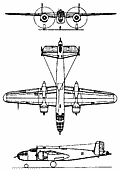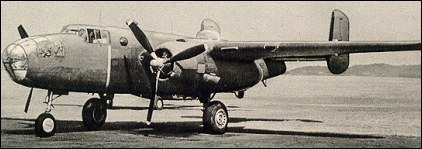|
| The first B-25 flew on August 19, 1940. More than 12000 aircraft built.

| MODEL | B-25J |
| CREW | 5 |
| ENGINE | 2 x Wright R-2600-92 Cyclone, 1268kW |
| WEIGHTS |
| Take-off weight | 15876 kg | 35001 lb |
| Empty weight | 8836 kg | 19480 lb |
| DIMENSIONS |
| Wingspan | 20.6 m | 68 ft 7 in |
| Length | 16.13 m | 53 ft 11 in |
| Height | 4.98 m | 16 ft 4 in |
| Wing area | 56.67 m2 | 609.99 sq ft |
| PERFORMANCE |
| Max. speed | 438 km/h | 272 mph |
| Ceiling | 7375 m | 24200 ft |
| Range | 2173 km | 1350 miles |
| ARMAMENT | 12 x 12.7mm machine-guns, 1300-1800kg of bombs |
 | A three-view drawing (592 x 842) |
| Gary Bailey, e-mail, 08.11.2011 00:59 I am from Presque Isle,Maine & joined the Marines in 1955 but recall the
f-89 scorpion flying about.Quite a scene.Also during ww-2 recall the sky full of planes taking off for Europe flying out over my house in Fairview acres reply | | gary Bailey, e-mail, 08.11.2011 00:50 My brother Parker E Bailey Jr. was a gunner on the
b-25 in the Rabaul area.Squardon 423.He passed a way a few years ago.As far as I know he wasnt aware of reunions.I have a picture that was in his possesion of Nick Lucarelli,Long Island,NY.My brother wrote on the reverse side"He went down one night in the Pacific ocean.I did not see him again until at the slope shut in El Toro.I have the picture of Nick standing in front of a B-25.I would like to give this picture to him 0r one of hia relatives.My E-mail is madtownmarine@yahoo.com.Regards Gary bailey reply | | bombardier, e-mail, 25.05.2011 09:39 The B-25G and H had a 75mm cannon and 14 machine-guns by far the heaviest armament fitted to a bomber during WW2 reply | | Raymond Scott, e-mail, 22.04.2011 21:03 I have been researching the military history of my uncle, 2nd Lt. Raymond C Ostronik, who piloted a B-25G named Bill's Delight II. He served with the 48th Bombardment Squadron in the Central Pacific flying from Apamama, Makin and finally Saipan before he was shot down over Guam in August 1944. I am amazed at the transformations in the armament and use of this incredible aircraft over the coourse of the war. I am interested in any information available on the 47th and 48th Bomb Squadrons during 1944. reply |
|
| | Jesse J. Craddock, e-mail, 10.04.2011 01:26 I was an Advanced Flying instructor in B-25s for 11 months
before going to combat in Italy.I had over 1000 hours in
the B-25 before I flew 46 Missions. An easy aircraft to fly,
no bad characteristics and was reliable --and could "take a
beating". I also flew it home to the USA as did many others.
321Bomb Group 447 Bomb Sq. 12th A.F. reply | | John Irwin, e-mail, 08.04.2011 06:55 I have a few B-25 flights as co-pilot and a number of flights as passenger. Base Ops at Perrin had 2 B-25s and whenever they needed a co-pilot, they would grab anyone at the fighter squadron who was not flying at the moment. It is one noisy beast. At that time I had never flown multi-engine and it felt terribly heavy and awkward to me. I later flew C-119 and C-123 and appreciated the B-25 a lot more. reply | | ric bradshaw, e-mail, 19.03.2011 20:20 My father, William "Brad" H Bradshaw was a B-25 Mitchell pilot with the 13th Airforce, 390th Bomb Group,42nd Bomb(medium)from 1943-1944 flying over 56 missions...I have all his logs...mostly against Rabaul from Stirling island (not much of an island just long enough for a runway). He is 94 and still sharp as a tack...and finally telling me what he experienced. An amazing man..I am trying to have him add some stuff to this site...as well as preserve his detailed records for posterity. He loved the Mitchell but finally got to fly the A-26 at the end of the war ..that was his favorite plane. God bless their generation..the likes of which we will probably never see again. reply | | Ben Beekman, e-mail, 04.03.2011 04:49 Using the twin-engine B-25 instead of conventionasl single-engine carrier planes was what made the 1942 Doolittle raid on Tokyo possible. The Japanese mainland forces had been alerted by radio signals from one of their picket boats which was at sea about 700-800 miles east of Tokyo. The picket boat, having sighted the American force, was sunk by gunfire but not before it had radioed a warning of "three" American carriers (two, actually, Hornet and Enterprise) approaching Japan. Thinking the carriers would have to close to within 300 miles before launching their planes, which the Japanese assumed would be single-engine, short radius of action types, the Japanese thought they had plenty of time to get ready for the anticipated attack. They had no idea that an aircraft carrier could launch long-range twin-engine bombers requiring take-off distances far in excess of the length available on a carrier. Neither did they know Doolittle's fliers had trained in take off distances of 500-700 feet under the tutelage of the navy. The Hornet, racing into a 25 knot headwind at 30 knots, could and did launch all 16 bombers successfully (but ahead of schedule) taking the forewarned Japanese by surprise. After dropping their bombs on Tokyo, though, the B-25's lacked enough fuel to make it to the intended airfields in China. All the planes except one which landed safely in Vladivostok were lost. Of the crewmen who went on the mission most returned to the U.S. except for the survivors of two crashed aircraft who were later captured by the Japanese. reply | | Don Kaiser, e-mail, 02.03.2011 01:52 The B-25 was a very important aircraft in the Middle East, North Africa, and Mediterranean during WWII. There were 5 USAAF bombardment groups (BG) that used this aircraft for tactical and strategic bombing missions. They were the 12th, 310th, 319th, 321st, and 340th BG. Perform a google search for B-25 Mitchell Medium Bombardment Groups of the MTO. reply | | W. Kernaghan, e-mail, 18.02.2011 02:24 Helped assemble B-25s at the KCK plant in 1942. Many fond memories doing the electrical wiring of the center section.
Then got drafted for WWII in Europe. That Channel storm was really rough.
Normandy, Battle of the Bulge, etc. reply | | David Fish, e-mail, 10.02.2011 00:16 My father was a PBJ-1 pilot assigned to Marine Bombing Squadron VMB-611 (MAG-32, MAGSZAM), Moret Field, Zamboanga, Mindanao, Philippine Islands. He flew 25 combat missions in both the PBJ-1D and PBJ-1J models. He and his crew went MIA 30 May 1945 during a strike on Kibawe Trail, flying PBJ-1J "MB 11".
As a member of the CAF, SoCal Wing, we are restoring the only official PBJ-1J (BuNo 35857) existing today. reply | | Jerry Zeilman, e-mail, 08.01.2011 01:28 As a 13 yesrold living in Kansas City, KS I used to set on the bluffs above Fairfax Field and watch new B-25s taking off. I never emagined 11 years later I would be stationed at Vance AFB( 52 - 54)and be crew chief and flight engineer on a TB-25L (914). Like Dick Adams, I read Hattensteins book and reminisced my days at Vance. reply | | Dick Adams, e-mail, 06.01.2011 03:16 I also was at Vance AFB, Enid OK from 1949-1952 and a Flight Engineer on TB-25J's. I bought the book "Behind the Copilot Seat" read it in one sitting, found my experiences very similar to those of C.P. Hattenstein, post 27.02.2010. The best, most informative years of my life. reply | | Bob Stangier, e-mail, 20.12.2010 05:24 I flew 70 missions out of Corsica and northern Italy 1044-45. The B-25 probably kept me alive as it was indestructable. reply | |
| | John Setser, e-mail, 14.12.2010 00:58 My first assignment in the AF was Waco, Texas working in the Inspection Dock on B-25's. Dock chief was MSGT Oliver. Don't remember any other names. The B-25 was used in the Navigator training program along with the T-29's. Spent several months on the 25's then transferred to the T-29's. reply | | Larry Bell, e-mail, 04.12.2010 17:50 In 1958 the B-25 was used at James Connally AFB in Waco TX as a trainer to transition navigators to the RIO position in the F-89 interceptors which were
also at James Connally. Went from there to the 76th FIS at McCoy AFB at Orlando
as a RIO in F-89H and J in1958-1960. reply | | a.casais, e-mail, 24.11.2010 13:55 This one is another of my favorites planes, and i think is the one to do everything even a "X-Files" history. That happen over the monanghela river(i think) or Ohio river around Pittsburgh, PA, when a B-25 felt down in the river, a very close night and never ever was found,is like was vanished.Everybody said over there was a special transporting operation with some kind of weird staff from....you know what i mean.This is so famous, is a big mural with a painting of event at the shore of the river.Cool!!!! reply | | Phil Stromowsky, e-mail, 05.11.2010 03:56 I had the privilege of flying the B-25 in flight school (Class 56-Q) out of Vance AFB in Enid, OK. A great experience in a classic airplane. reply | | Joe A Meeker, e-mail, 02.11.2010 21:14 Flew them at Vance AFB back in 1956 (56-I) Aviation Cadets...we may have been the last Cadets there. A great aircraft, easy to fly,land & takeoff. Good practice for my next one, the Douglas B-26. reply | | R.J. Parker, e-mail, 19.10.2010 07:06 My dad Jim Parker was co-pilot on plane #9 on the Doolittle Raid, April 18, 1942. Although this plane was lost, I have his letters about this aircraft, and what a great piece of equipment he said it was. He piloted more time in the B-26 in North Africa, but always loved the B-25 the best. Natives of his small home town still speak of times he would buzz the town in the B-25. reply |
|
Do you have any comments?
|
| 
COMPANY
PROFILE
All the World's Rotorcraft
|














I am the great nephew of Robert Servis. Radio man and gunner on that plane. Tail number 875. I've been looking for family of the crew for some time now. If you don't know what happened I have many missions reports. I'm looking for photos because the national archives had a fire in the '70s and sent me a copy of the only surviving picture of the crew. Let's talk.
reply